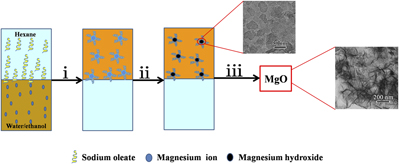Crossref Citations
This article has been cited by the following publications. This list is generated based on data provided by
Crossref.
Deng, X. Z.
Wang, Y. W.
Peng, J. P.
Liu, K. J.
Feng, N. X.
and
Di, Y. Z.
2016.
Surface area control of nanocomposites Mg(OH)2/graphene using a cathodic electrodeposition process: high adsorption capability of methyl orange.
RSC Advances,
Vol. 6,
Issue. 91,
p.
88315.
Satheesh, R.
Vignesh, K.
Rajarajan, M.
Suganthi, A.
Sreekantan, Srimala
Kang, Misook
and
Kwak, Byeong Sub
2016.
Removal of congo red from water using quercetin modified α-Fe2O3 nanoparticles as effective nanoadsorbent.
Materials Chemistry and Physics,
Vol. 180,
Issue. ,
p.
53.
Shi, Xian-He
Ban, Jin-Jin
Zhang, Li
Sun, Zhi-Peng
Jia, Dian-Zeng
and
Xu, Guan-Cheng
2017.
Preparation and exceptional adsorption performance of porous MgO derived from a metal–organic framework.
RSC Advances,
Vol. 7,
Issue. 26,
p.
16189.
Bai, Zongquan
Zheng, Yajun
and
Zhang, Zhiping
2017.
One-pot synthesis of highly efficient MgO for the removal of Congo red in aqueous solution.
Journal of Materials Chemistry A,
Vol. 5,
Issue. 14,
p.
6630.
Deng, Xinzhong
Wang, Yaowu
Peng, Jianping
Liu, Kejia
Feng, Naixiang
and
Di, Yuezhong
2017.
Mg(OH)2/Graphene Nanocomposites Prepared by Cathodic Electrodeposition for the Adsorption of Congo Red.
Nano,
Vol. 12,
Issue. 02,
p.
1750017.
Zheng, Yajun
Cao, Liyun
Xing, Gaoxuan
Bai, Zongquan
Shen, Hongyan
Huang, Jianfeng
and
Zhang, Zhiping
2018.
Influence and its mechanism of temperature variation in a muffle furnace during calcination on the adsorption performance of rod-like MgO to Congo red.
Frontiers of Materials Science,
Vol. 12,
Issue. 3,
p.
304.
Zhang, Heng
Chen, Hang
Azat, Seytkhan
Mansurov, Zulkhair A.
Liu, Xueming
Wang, Jide
Su, Xintai
and
Wu, Ronglan
2018.
Super adsorption capability of rhombic dodecahedral Ca-Al layered double oxides for Congo red removal.
Journal of Alloys and Compounds,
Vol. 768,
Issue. ,
p.
572.
Hu, Mengqing
Yan, Xinlong
Hu, Xiaoyan
Zhang, Jiajin
Feng, Rui
and
Zhou, Min
2018.
Ultra-high adsorption capacity of MgO/SiO2 composites with rough surfaces for Congo red removal from water.
Journal of Colloid and Interface Science,
Vol. 510,
Issue. ,
p.
111.
Zhang, Hongyu
Hu, Jindou
Xie, Jing
Wang, Shiqiang
and
Cao, Yali
2019.
A solid-state chemical method for synthesizing MgO nanoparticles with superior adsorption properties.
RSC Advances,
Vol. 9,
Issue. 4,
p.
2011.
Nagpal, Mudita
and
Kakkar, Rita
2019.
Use of metal oxides for the adsorptive removal of toxic organic pollutants.
Separation and Purification Technology,
Vol. 211,
Issue. ,
p.
522.
Borgohain, Xavy
Boruah, Anakshi
Sarma, Gautam Kumar
and
Rashid, Md. Harunar
2020.
Rapid and extremely high adsorption performance of porous MgO nanostructures for fluoride removal from water.
Journal of Molecular Liquids,
Vol. 305,
Issue. ,
p.
112799.
Tang, Ying
Li, Zhaoyi
Xu, Zhongying
Zhang, Jie
Qu, Chengtun
and
Zhang, Zhifang
2020.
Synthesis of hierarchical MgO based on a cotton template and its adsorption properties for efficient treatment of oilfield wastewater.
RSC Advances,
Vol. 10,
Issue. 48,
p.
28695.
Masindi, V.
2021.
Conversion of cryptocrystalline magnesite to MgO nanosheets: Insights into microstructural properties.
Materials Today: Proceedings,
Vol. 38,
Issue. ,
p.
1077.
Liu, Meng
Yin, Wei
Zhao, Tian-Lei
Yao, Qi-Zhi
Fu, Sheng-Quan
and
Zhou, Gen-Tao
2021.
High-efficient removal of organic dyes from model wastewater using Mg(OH)2-MnO2 nanocomposite: Synergistic effects of adsorption, precipitation, and photodegradation.
Separation and Purification Technology,
Vol. 272,
Issue. ,
p.
118901.
Benisha, R.
Amalanathan, M.
Aravind, M.
Mary, M Sony Michel
Ahmad, Awais
Tabassum, Sobia
Al-Qahtani, Wahidah H.
and
Ahmad, Ikram
2022.
Catharanthus roseus leaf extract mediated Ag-MgO nanocatalyst for photocatalytic degradation of Congo red dye and their antibacterial activity.
Journal of Molecular Structure,
Vol. 1262,
Issue. ,
p.
133005.
Kim, Se-Hee
Kim, Dong-Su
Moradi, Hiresh
Chang, Yoon-Young
and
Yang, Jae-Kyu
2022.
Rhodamine B and Congo Red Removal from Water Using Biobased Graphene-Like Carbon Adsorbent; Synthesis and Adsorption Mechanisms, Kinetic and Thermodynamic Study.
SSRN Electronic Journal ,
Borgohain, Xavy
and
Rashid, Harunar
2022.
Rapid and enhanced adsorptive mitigation of groundwater fluoride by Mg(OH)2 nanoflakes.
Environmental Science and Pollution Research,
Vol. 29,
Issue. 46,
p.
70056.
Jumaeri, Jumaeri
Nadiyya, Akhsanun
Prasetya, Agung Tri
and
Sumarni, Woro
2022.
Congo Red Dye Adsorption using Magnesium Hydroxide from Seawater Bittern.
Jurnal Kimia Sains dan Aplikasi,
Vol. 25,
Issue. 6,
p.
205.
Yadav, Pinky
Saini, Rimpy
and
Bhaduri, Ayana
2022.
Facile synthesis of MgO nanoparticles for effective degradation of organic dyes.
Environmental Science and Pollution Research,
Vol. 30,
Issue. 28,
p.
71439.
Tang, Xiaojia
Wang, Yufei
Zhu, Yimin
and
Ji, Yangyuan
2023.
Preparation of Mg(OH)2 Microsphere by Gas-Continuous Impinging Streams for Congo Red Absorption Removal.
Water, Air, & Soil Pollution,
Vol. 234,
Issue. 11,





